Being Italian, I was raised knowing exactly how long to boil spaghetti (pasta). You will find EVERYTHING YOU NEED TO KNOW (plus MORE) in this incredibly thorough post to boil pasta like a pro.
Following in-depth research and my own experience and knowledge, I’ve compiled the most frequently asked questions and detailed instructions for making pasta that’s cooked perfectly (just like a real Italian). You’ll only cook pasta this way from now on because it makes such a difference.
This method is for dried store-bought pasta. The cooking instructions for fresh pasta can be found in these recipe posts if you want to make your own authentic homemade pappardelle pasta or homemade ravioli.
With perfectly cooked spaghetti or bucatini, the authentic Italian pasta puttanesca sauce shown in the photo is delicious. [feast_advanced_jump_to].
How do you boil Spaghetti?
Here is a quick guide to the ideal methods for cooking pasta. See headings for details and explanations of each step.
The best method for cooking spaghetti pasta:
- Spaghetti should be stirred back and forth in the pot until it softens and begins to float freely (see pictures below).
(Short pasta varieties can be prepared using the same technique; just use a smaller pot.)
How to boil Spaghetti- a photo guide
adding the salt and the pasta after the water has boiled The section of this post titled “When to Salt Your Pasta Water” contains more information on why this is crucial.
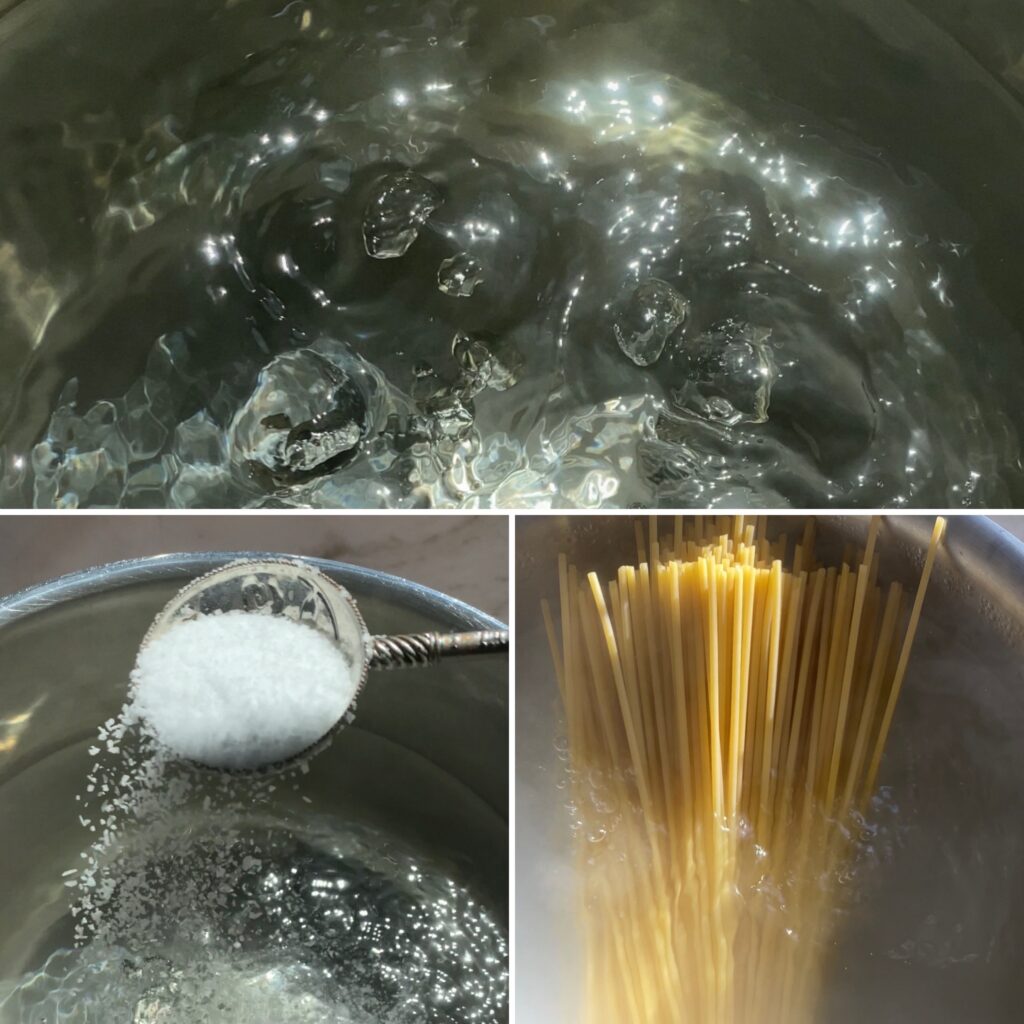
Stir spaghetti back and forth until it becomes sufficiently soft to float on its own in the water.
In the section titled “How much water do you use to boil spaghetti?” you can learn more about the importance of using a large pot and the appropriate amount of water.
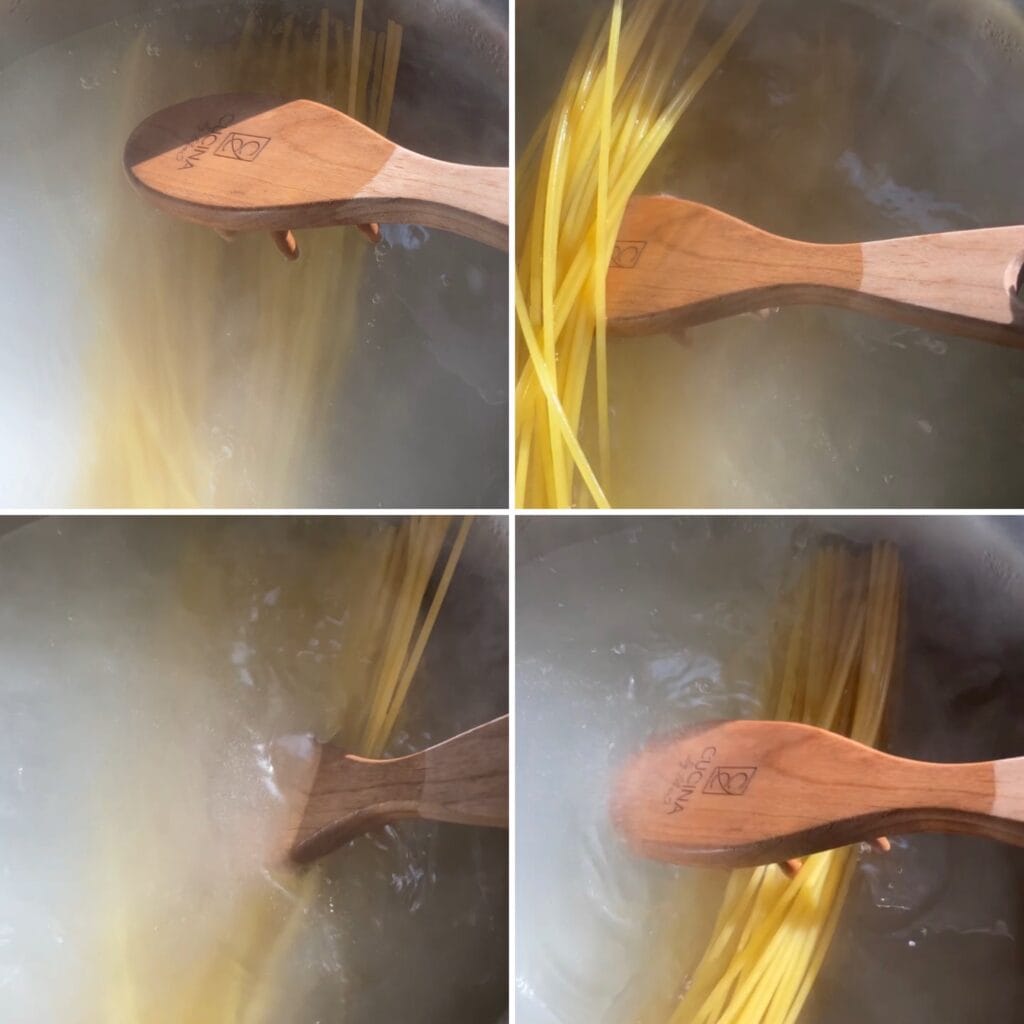
Stir Spaghetti often and test pasta before draining. Don’t forget to reserve some of the pasta water for the sauce!
Read more about this in the section titled “Why you should save your pasta water,” then combine hot pasta with sauce right away.
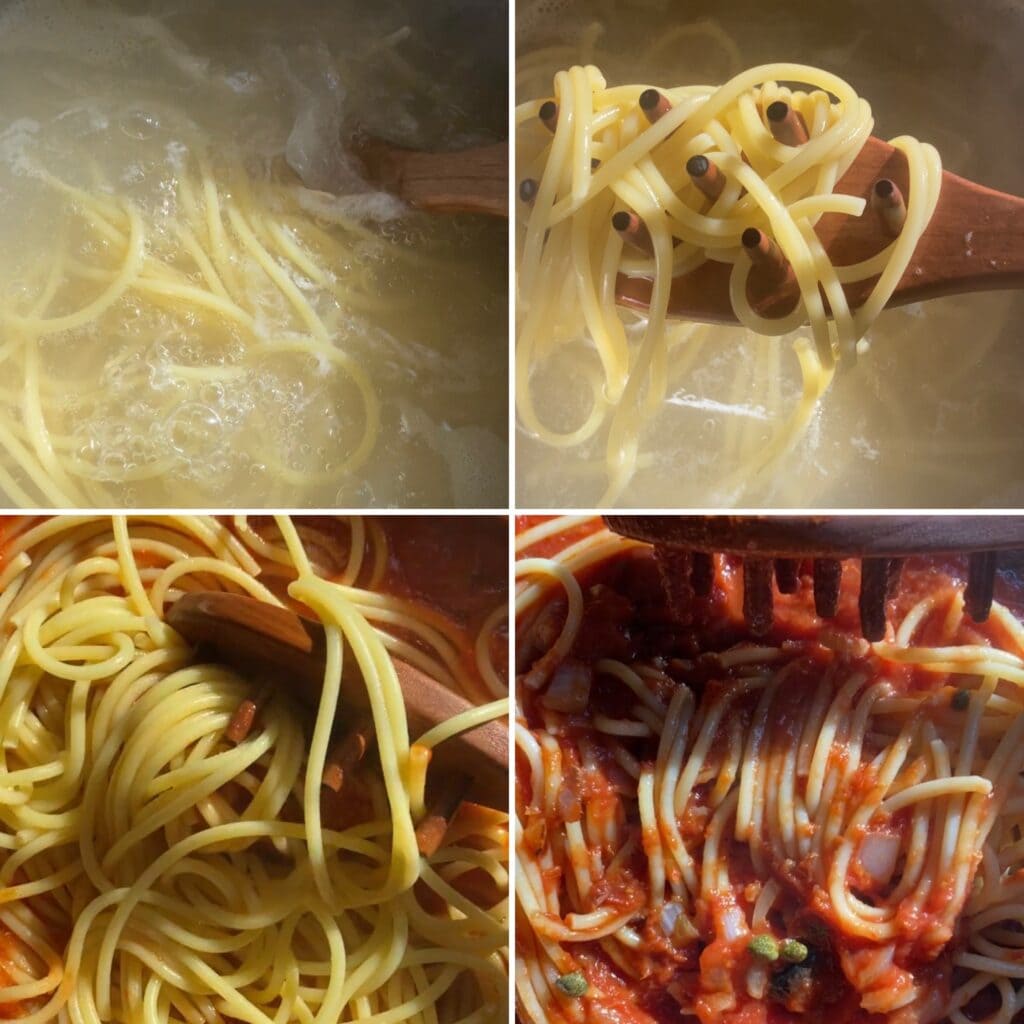
How do you cook Spaghetti without it sticking?
Do you regularly add butter or olive oil to pasta water to keep it from sticking? MYTH: Adding butter or oil to pasta water prevents it from sticking. This negatively affects the final pasta dish you prepare.
Tips for making pasta without it sticking:
I understand that you are busy, but you let the pasta sit or, worse, add oil to coat it BEFORE mixing with the sauce even though it is done. If you must choose, leave the pasta undrained and let the sauce sit!
TIMING its all about TIMING
AVOID adding butter or oil before combining the pasta and sauce. Your pasta won’t ever absorb your sauce because it will simply slide off. There is no going back.
The measuring and serving equipment I use for pasta is shown here. It is similar to a pasta fork but better, a multipurpose Italian cooking tool made especially for you!
When gently stirring, draining, and serving spaghetti and other types of pasta, use your pasta server’s fork-like teeth.
For spaghetti, the holes in the handle serve as a portion guide (uno = 1, due = 2, quattro = 4). Its also great for stirring sauces and risotto!.
Your utensil is exquisitely made by hand from 100% cherry wood, is sturdy, decorative, and arranges itself neatly in a kitchen tool drawer or in a utensil holder.
Safe for use with nonstick cookware; hand wash only; top-coat cherry wood with mineral oil on occasion to maintain its best-looking appearance Handmade in Salt Lake City, Utah USA.
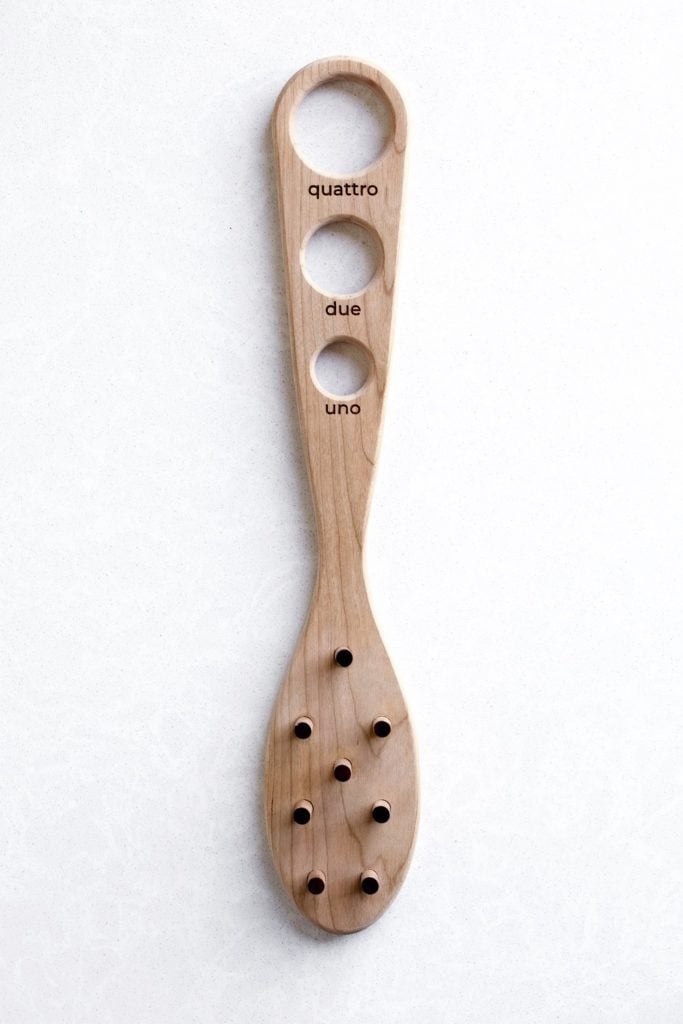
Do you need to put oil in pasta water?
No, it is actually preferable if you do not add oil. Generally, people add oil to prevent the pasta from sticking. Without adding any oil to the boiling water, use the advice above to prepare pasta like a pro.
How long should you boil pasta?
Look at the box and plan before preparing the meal. Checking after four minutes is a good idea because the size will vary slightly depending on the quality and shape of the pasta. The boiling times for different types and thicknesses of pasta range from about 7 to 14 minutes.
You only need to boil fresh pasta for one or two, sometimes three, minutes.
How long do you cook Spaghetti?
Spaghetti typically needs 8 to 10 minutes to reach an al dente texture (variety dependent). Look at the box and plan before preparing the meal.
Because it cooks so quickly, the pasta should be the very last item you cook when preparing your meal.
Tip: have your sauce ready before cooking the pasta!
Cooking Pasta ‘al dente’
If you’re Italian, you’ve probably heard the phrase “cook your pasta al dente,” but what does that actually mean, why does it matter, and how do you do it?
What does ‘al dente” mean?
Al dente translates as close to the tooth or having a light bite. Here is an illustration of al dente lasagna pasta:
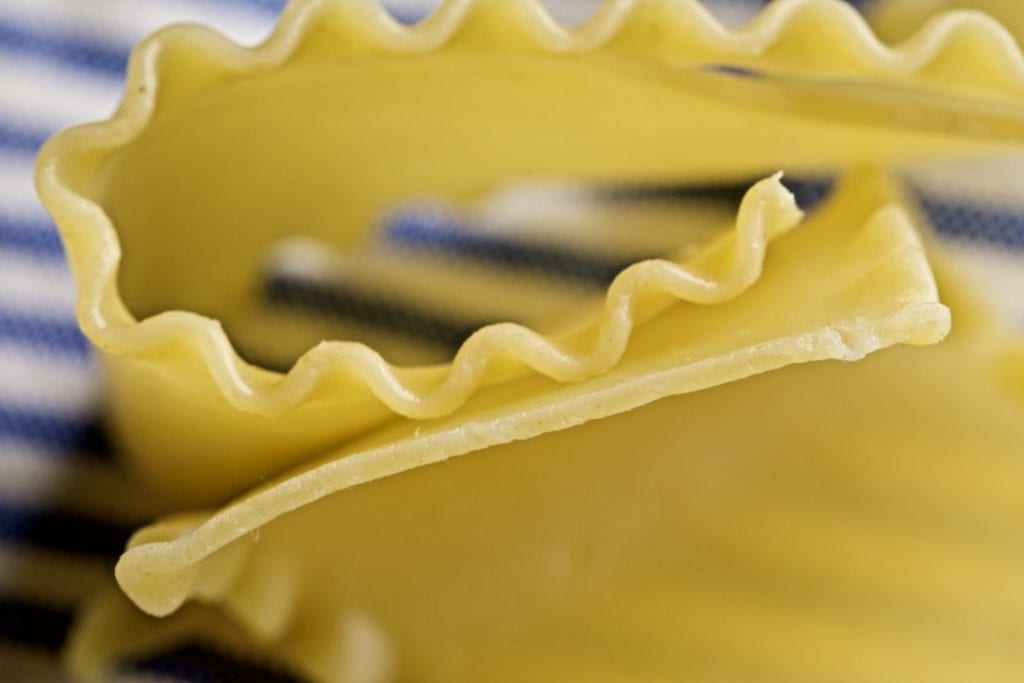
For your next special meal, prepare Traditional Italian Lasagna Bolognese with Bechamel Sauce!
WHY cook pasta al dente?
If pasta is overcooked, the GI index will increase, which means that al dente pasta will digest and absorb nutrients more slowly than overcooked, mushy pasta. It also just tastes better :). Try it this way when making Shrimp Scampi Pasta Recipe.
HOW long to cook pasta al dente
Set a timer for 2-3 minutes before the directions on the package, measure your quantity, stir, and use a large pot of heavily salted water (never add oil).
Make sure to TASTE test the pasta to ensure that it is properly al dente at the end of the cooking time. You may need to add a few minutes or it may be done earlier than anticipated. Mangia! (Eat!).
Why taste testing pasta matters
You must taste your pasta before draining it to ensure that it has the right texture, so do not cook and drain without doing so. How else do you know its truly done- al dente?.
How to properly taste test pasta:
What stove setting for pasta?
Start the water on high heat to bring it to a boil as quickly as possible (unless you want to delay the boil).
The heat will be interrupted when you add the pasta, and it will take some time for it to resume boiling. Reduce heat to medium-high or low after it returns to a boil to prevent your pot from overheating while the pasta cooks.
Keep in mind that the water’s movement aids the pasta’s movement and even cooking.
Tip for Hosting: When I make pasta for guests, I usually bring the water to a boil, cover it with a lid, and then reduce the heat to a low simmer. I keep the water warm so that I can quickly bring it to a boil when it’s time to add the pasta.
How much water do you use to boil Spaghetti?
You need 4 quarts of water to make spaghetti. In general, if I’m making 1 pound of pasta, I use this much for other kinds of pasta as well. Depending on how much pasta you are making, you can change this ratio.
The best way to cook pasta is to use plenty of water in a large pot so that it can freely swim around. This also helps the pasta cook evenly.
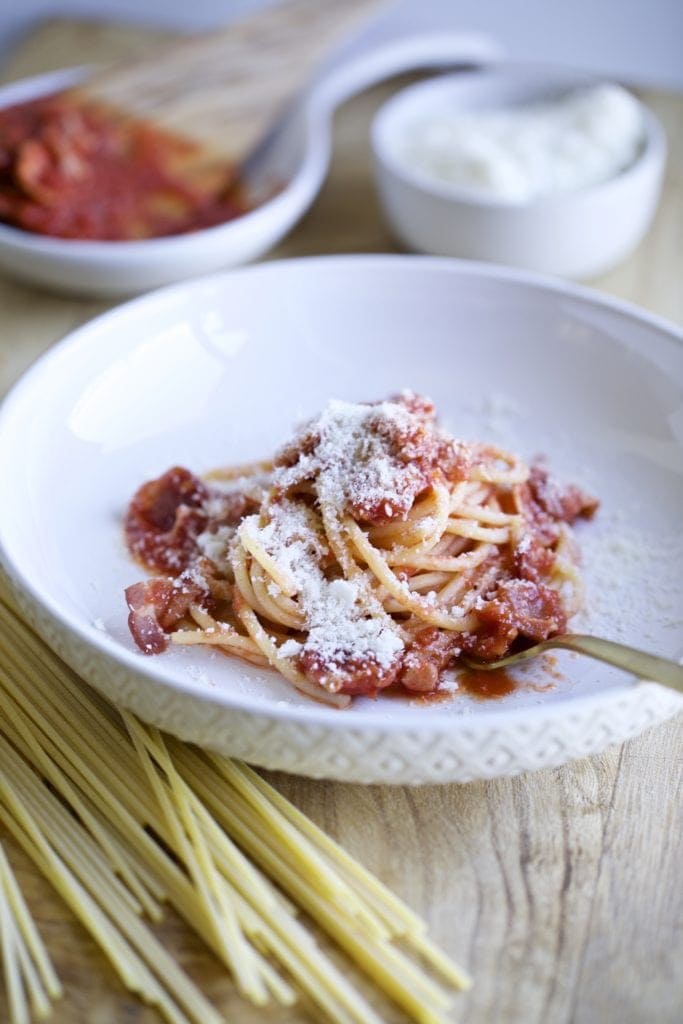
Quick and easy Spaghetti with Authentic Italian Amatriciana Sauce recipe.
Why you should save your pasta water
Keep the starchy cooking water aside when you cook pasta and serve it with a sauce. There are several good reasons to do so:
Try this method and let me know what you think!
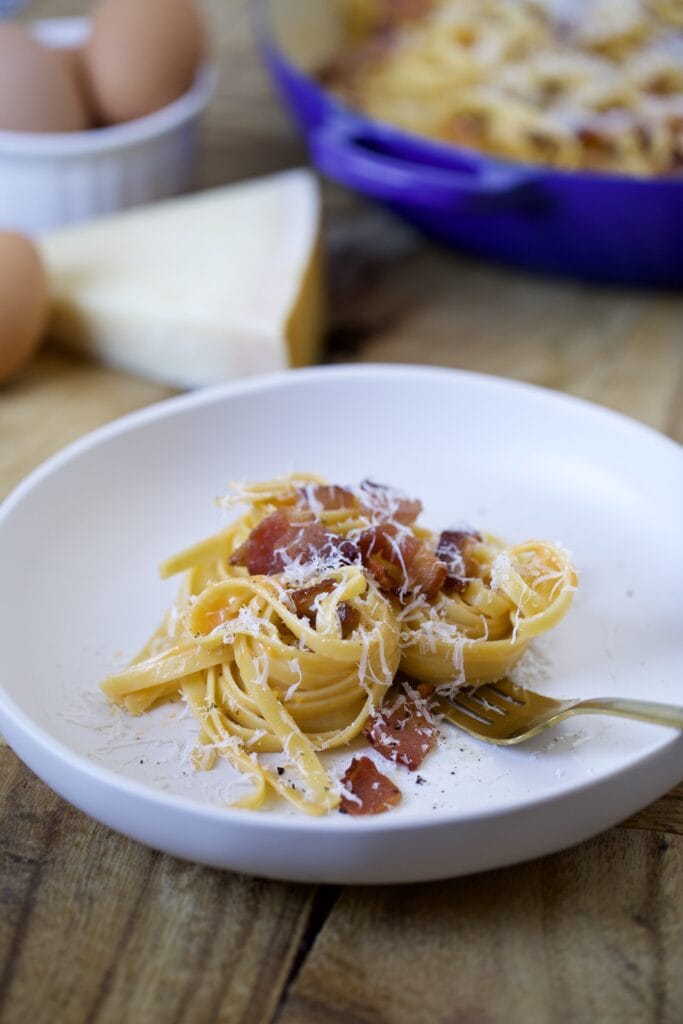
How much Spaghetti should I cook per person?
It’s simple to over- or underestimate how much spaghetti or pasta you really need, so do you DUMP or measure your pasta?
Take a moment to measure portions rather than dumping in a random amount and getting way too much or not enough.
After a few measurements, you’ll form the habit of remembering how much to measure for each person.
Tips for Measuring Pasta
I dont store leftover PLAIN (unseasoned) pasta in my fridge. I usually make double my sauces and save the sauce. Then, all I have to do to prepare a healthy meal is cook my pasta!
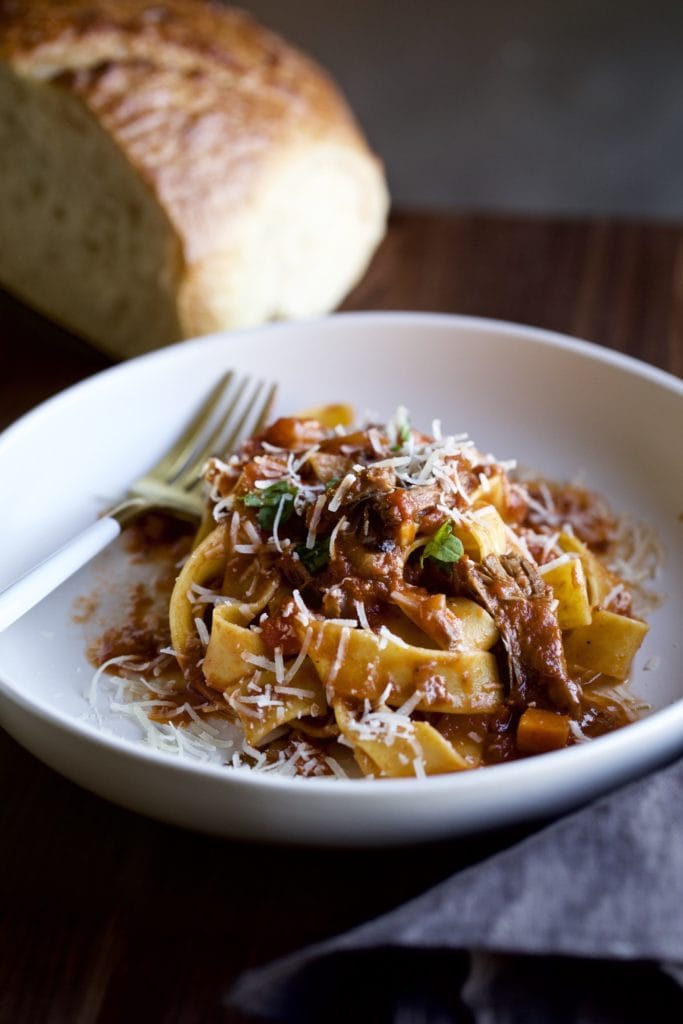
Should you rinse pasta?
When you rinse your pasta, you are rinsing liquid GOLD, so if you are Italian, the answer to this question is always NO!
Italian pasta should never—I mean never—be rinsed, with the exception of gluten-free pasta. Here’s why:
Should you rinse pasta for cold pasta salad?
Despite the widespread misconception—shared even by many chefs—that you should rinse your pasta in cold water before serving it cold, my response is still no.
Here are some reasons why you DON’T NEED TO DO THIS when making cold pasta salad:
Rinsing strips the starches from the pasta. In the end, this has a negative impact on the dish’s overall flavor and texture. WHAT TO DO INSTEAD….
TRY IT. This may not be the most common method, but it is the best way to make pasta salad!
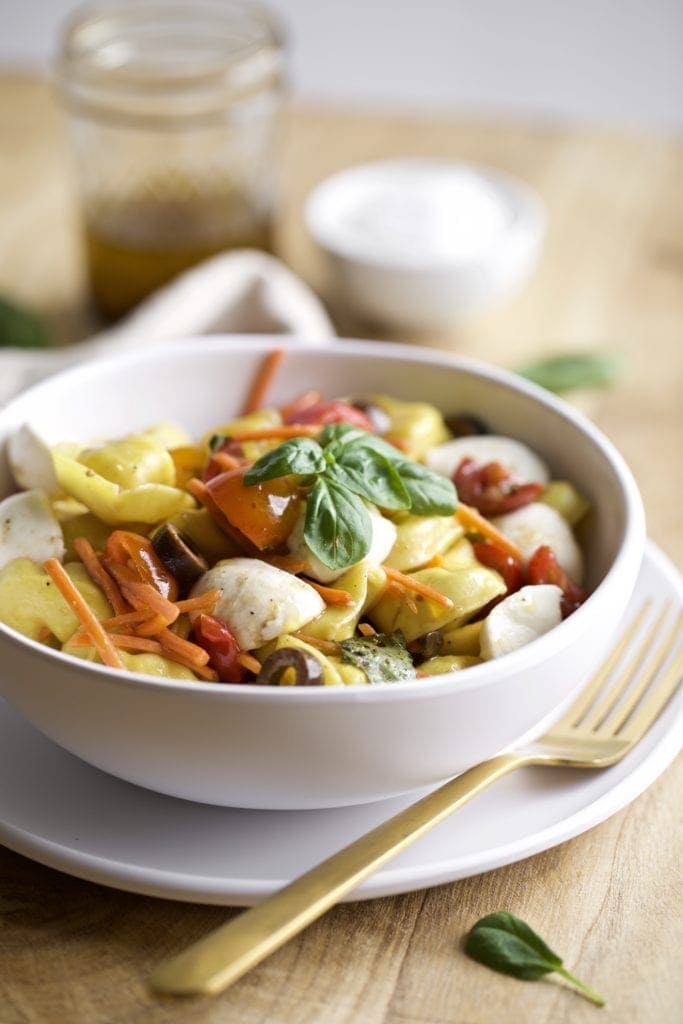
How to properly salt your pasta water
We often advise people to “salt their pasta water like the sea,” but what does that really mean?
TIPS: 1:2:4
When to salt pasta water?
The key question is not whether to salt your pasta water, but rather when. Here are a few rules to follow:
When to salt pasta water:
The pasta will still absorb salt even in the final 30 seconds of cooking, so don’t worry if you forget the salt and don’t realize it until you taste test the finished dish. Before draining it, hastily add your salt and stir vigorously.
Do you cover pasta while boiling?
If you are asking an Italian- no! You need the water to be at a gentle boil while the pasta is cooking. It is okay to cover the pot while you are trying to get the water to boil, but not after the pasta is added.
Since you will need to lower the heat sufficiently so the water won’t boil or bubble over the pot, if you cover the pasta with a lid while it cooks, it won’t cook as well.
In general, pasta will cook more quickly the thinner it is. For example, angel hair will cook faster than fettuccini. The grain of high-quality bronze-cut pasta is usually harder and requires more time to cook. Although the pasta will cook more quickly if it is more transparent and of lower quality, the flavor will be compromised.
Most kinds of pasta last in the fridge for 3–5 days. Before storing the cooked pasta or leftovers let the pasta cool slightly. Make sure to use a proper airtight container for storage.
1- Start with a large pot of COLD water. Hot water from the tap often contains added minerals that can damage pots and alter taste. 2- Use a large pot (this is the one I use). This allows movement for the long pasta (a good rule of thumb for short pasta) 3- Make sure you have plenty of water in the pot. (see post for exact measurements) 4- Salt the water. This is an Italian MUST to flavor the pasta from the inside out. 5- Bring the water to a full boil, or rolling boil, before adding the spaghetti noodles or pasta. 6- Stir occasionally with the proper utensil to keep the pasta from sticking. 7- Test the pasta two minutes before its “al dente”. 8- Save a scoop of pasta water. Another Italian secret. 9- Drain, toss with sauce, and serve hot! This same method applies to short pasta varieties- you may use a smaller pot. See the post for more details!
Al dente, or to the tooth in Italian, refers to pasta that has been properly cooked. Not mushy or too firm- it is cooked just right. It’s crucial to avoid overcooking the pasta in the boiling water because it continues to cook when it’s mixed with hot sauce. No, al dente is not raw or undercooked pasta.
Popular Pasta Recipes you will love:
Share this article with your family and friends if you found it useful. Now, you can cook dry pasta perfectly every single time!.
Make sure to follow me on Instagram @cucinabyelena for more. To get more ideas follow me on Pinterest.
This post contains affiliate Amazon links.
FAQ
How long should you boil spaghetti noodles?
The most popular way to cook spaghetti is simple. Place the pasta in a large pot of boiling water, stir it, bring it to a simmer, turn off the heat, cover the pot, and let the pasta cook for 10 to 12 minutes.
How long does it take to cook raw spaghetti?
In addition to taste and texture, one benefit of fresh pasta is that it takes very little time to prepare. Fresh pasta, whether filled or unfilled, almost never requires more than 4 minutes to actually cook. Its dried, clearly inferior counterpart can frequently take longer than 15 minutes to prepare.
What is the best way to cook spaghetti noodles?
Spaghetti typically needs 8 to 10 minutes to reach an al dente texture (variety dependent). Look at the box and plan before preparing the meal. Because it cooks so quickly, the pasta should be the very last item you cook when preparing your meal. Tip: have your sauce ready before cooking the pasta!.
